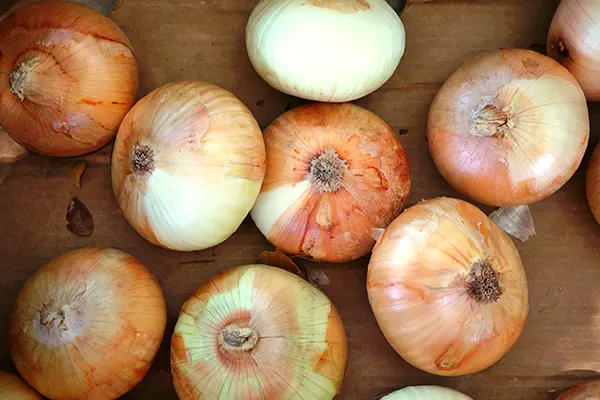Maui onions are sweet onions planted and grown on Maui. Maui onions, unlike other onions, aren’t grown in sulfuric soil so they lack the pungent smell and sharp taste of typical onions.
Because they’re crunchy, succulent, and sweet, Maui onions are used in many delicious recipes, and can even be eaten raw. Also, they don’t produce tears!
Below we detail everything about Maui’s extremely snackable onion.

What Onion Is Like A Maui Onion?
Table of Contents
Maui onions are not the only sweet onions on the block. There are other varieties of onion grown in sulfur-lacking soil, so that your eyes don’t sting as you cut into one.
Besides their obviously sweet taste they can sometimes be identified by color, ranging over red, yellow, white, and a yellowy-white—though that doesn’t necesarilly narrow down the bunch. So you’re better off reading the label.
Some other sweet onions include…
- Vidalia Onions originate from Vidalia in Georgia in the early 1900s. Research says that Moses Coleman from Toombs County is the first farmer to discover the Vidalia onion. At that time, he sold a 50-pound bag for as high as $3.50, very costly back then. Because of their natural popularity, other farmers began planting sweet onions.
- Walla walla sweets are soft, succulent, and sweet, just like its cousin, the Maui onion. They are grown at the foot of the blue mountains in the South-Eastern part of the state of Washington, and are ready for picking between June and August each year.
- Texas 1015 Sweet Onion are one of the best sweet onions in the world. Dr. Leonard Pike was a famous Horticulture Professor in Texas A&M University, Texas, who spent ten years researching and testing to fully develop this sweet onion variant. The Texas 1015 onion bears the same name as the date they plant onions in Texas, which is the 15th of October. These onions are available for sale from March to June of every year.
Are Sweet Onions The Same As Maui Onions?
As we mentioned above, Maui onions are sweet onions. But not all sweet onions are Maui onions.
Afterall, what makes a Maui onion is that the onions is grown on Maui, on the slopes of Haleakala. Makes sense, right?
Though Maui onions and sweet onions are, in general, certainly related enough, if not by strict genetic lines, then by taste and texture. Though there’s nothing quite like the experience of biting into a juicy Maui onion.
Are Maui Onions Vidalia Onions?
Maui onions and Vidalia onions are two different onions entirely. Maui onions are yellowy-white, and they look a little like a squashed globe. Maui onions contain more water and sugar content than the average yellow onion.
They are both sweet onions, but they differ in their origin and season of availability.
Maui onions are grown in Mount Haleakala’s rich, distinctive red volcanic soil. They’re available from May to December, and unfortunately, due to limited land, not many are grown each year (relatively speaking).
On the other hand, Vidalia Onions are very common as they are grown on a large swath of land in Vidalia, Georgia. Vidalia Onions mature from mid-April to mid-June and can be available till September.
How Do You Use Maui Onions?
Maui onions can be eaten either raw or cooked—and we suggest you give both a shot.
They can be grilled, fried, baked, steamed, sauteed, or broiled. They can be used fresh and used on sandwiches, or as ingredients in salads, or just bite into the onion whole. Maui onions can be paired with beef, grilled meat, fish, hazelnuts, etc.
They’re also great caramelized thanks to their sweetness, like candy caramelized onion.
Where Can I Buy Maui Onions?
You can easily find Maui onions in grocery stores at the produce department. They are occasionally bagged already from their produce distributor.
Keep an eye out for the label, “Kula grown.”
Maui’s onion season runs from May to December. Outside of the season, prices can run higher, or you may not find any Maui onions at the grocery story.
